As responsible travelers evolve, so do the stories we share.
This article is part of our living archive — trusted content we continue to care for.
First published on June 28, 2024 • Last updated on November 3, 2024.
We acknowledge that Wahclella Falls, located in the lower Columbia River Gorge, lies on the traditional territories of many tribes and bands who have inhabited and stewarded this land since time immemorial. The lower Columbia River, known as Wimahl in Upper Chinook and Nch’i-Wàna in Sahaptin, is home to tribes including the Chinook, Clatsop, Kathlamet, Wahkiakum, Multnomah, Cascades, Tualatin Kalapuya, Molalla, Wasco, Clackamas, Cowlitz, Skilloot, and Atfalati. These tribes have ancestral connections to this region and continue to maintain a deep and abiding relationship with these lands and waters.
We honor and respect the enduring relationship that exists between these tribes and their ancestral lands. We pay our respects to their elders, past and present, and extend that respect to all Indigenous people today.
It’s only been two days since I hiked to Wahclella Falls and I’m already planning a trip back. This stunning horsetail waterfall was in full flow, its ice-cold water forced through a narrow opening in the basalt rock face to land in a deep, crystal-clear, blue-green pool.
Wahclella Falls is my new muse. It has encouraged me to write my first article about my adopted home state, Oregon, and to research the modern-day and historic ties of Native American peoples with the Colombia River Valley and the greater Portland Metro Area.
From here on out, Not Your Average American will include land acknowledgements, an important step towards creating a better world for all Indigenous peoples.
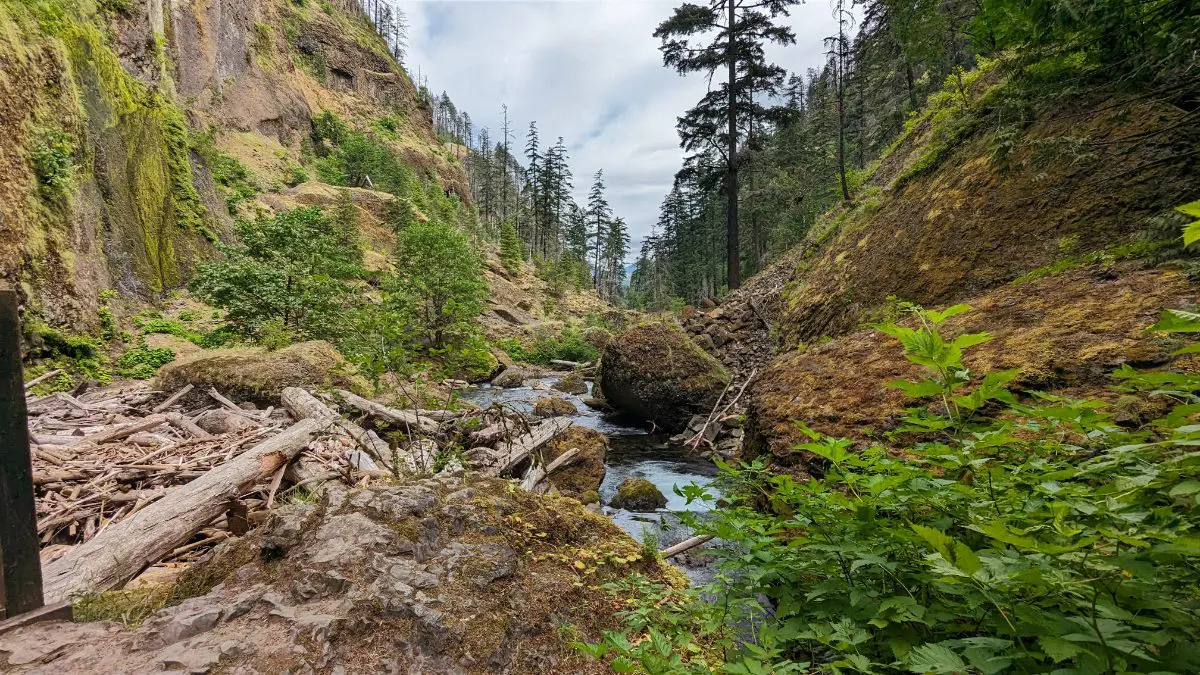
Why hike Wahclella Falls?
We chose to hike Wahclella Falls for several reasons.
First, hiking to waterfalls encourages me to be engaged and awake, two of the key concepts of traveling with HEART. There is a sense of anticipation throughout the hike, especially for an initial visit. What waits at the end of the trail? Hiking to waterfalls also encourages us to engage our senses – especially hearing – as the sounds of this mighty fall reach us before our eyes light on its beauty.
Second, as the first true hike of the season, I needed an easy trail. Hiking with MS is challenging and if I begin with a difficult hike, it can knock me out for weeks. The hike to Wahclella Falls is short, about 2.5 miles round trip, with easy elevation changes. It made for a perfect start to this year’s hiking season.
Third, we wanted wildflowers. This trail is known for a great selection of late spring blooms. We were not disappointed!



What to Expect at Wahclella Falls
For our readers that like to know what to expect, we arrived mid-morning to the trailhead parking lot. You will need to have a US Federal Park Pass, a US Forest Pass for Oregon and Washington, or a Columbia River Gorge Pass BEFORE arriving. There is not a pay box on site. It does look as if some people park outside and hike in.
We immediately took advantage of the recently cleaned portapotties. Then we hit the trail. We started hiking side by side on the wide path, admiring Tanner Creek to the right as it rambled towards the mighty Columbia River.
A short distance in, we found a sign advising us that we were entering the Mark O. Hatfield Wilderness area. Hatfield was a career politician who served more than 30 years in the US Senate and 8 years as Oregon’s governor.

Past this point, the trail narrows and slowly gains elevation. I was pleasantly surprised to find a well-maintained trail that was easy to hike, especially with proper gear like hiking boots or trail shoes rather than tennis shoes or sandals. Bring your hiking poles, especially for the few places with steep elevation changes.
We had unintentionally started our hike just as the sun was rising over the eastern ridge of the canyon, sunlight bouncing off the western face. We hiked in the shade, enjoying the coolness of the morning for the entire hike to the waterfall. We passed wildflower after wildflower. We saw the last of the spring strawberries and the first of the summer thimbleberries.

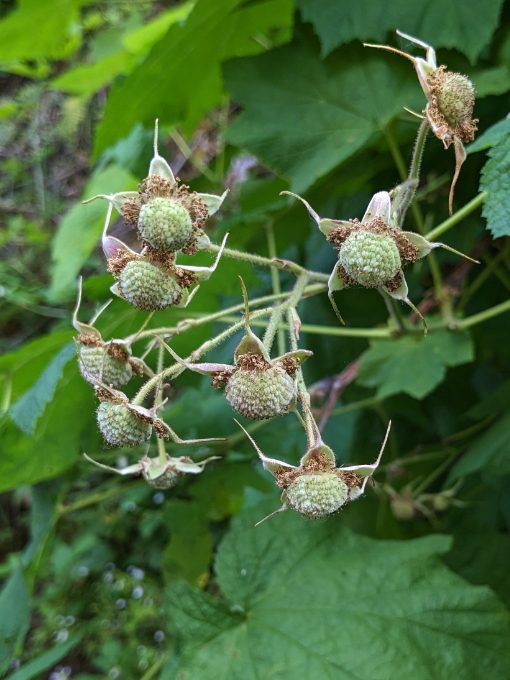
We ran into a workers replacing beams on one of the footbridges that cross the many creeks and ravines. It was a reminder that this trail only recently reopened after the 2017 Eagle Creek wildlife devastated 48,000 acres in the Columbia River Gorge, including this forest. Every few yards, we spotted another blackened trunk. Surprisingly, some of these trees show signs of survival while others are beyond hope of recovery, despite standing like sentinels along the ridge.

We found an unexpected fork in the trail. Nothing we had seen at the trailhead hinted at a choice or a loop. But, here we were, choosing to take the high road, the lefthand fork. We often choose to hike up before hiking down, especially when a waterfall is our goal.
Not long after, we could no longer make out the sound of the river below us. Instead, we heard the crashing of a waterfall, that consistent reverb as water smashes into an amphitheater carved out of basalt cliffs. The air changed, thickening with minuscule drops of water so light that we couldn’t feel them with our fingers. But my nose noted the difference. We caught a glimpse of bright whiteness falling into nothingness through the trees.

We arrived in perfect concert with the morning sun. Though it did not shine down into the inner circle, the light from the sky above provided magical illumination. The water seemed to glow from within, a cold fire of blue light emanating from its depths. Deep green mosses and bright green ferns competed for attention on the steep, stone walls. The waterfall and its froth were as white as snow with hints of blue, reminding me of Alaskan glaciers in mid-summer.
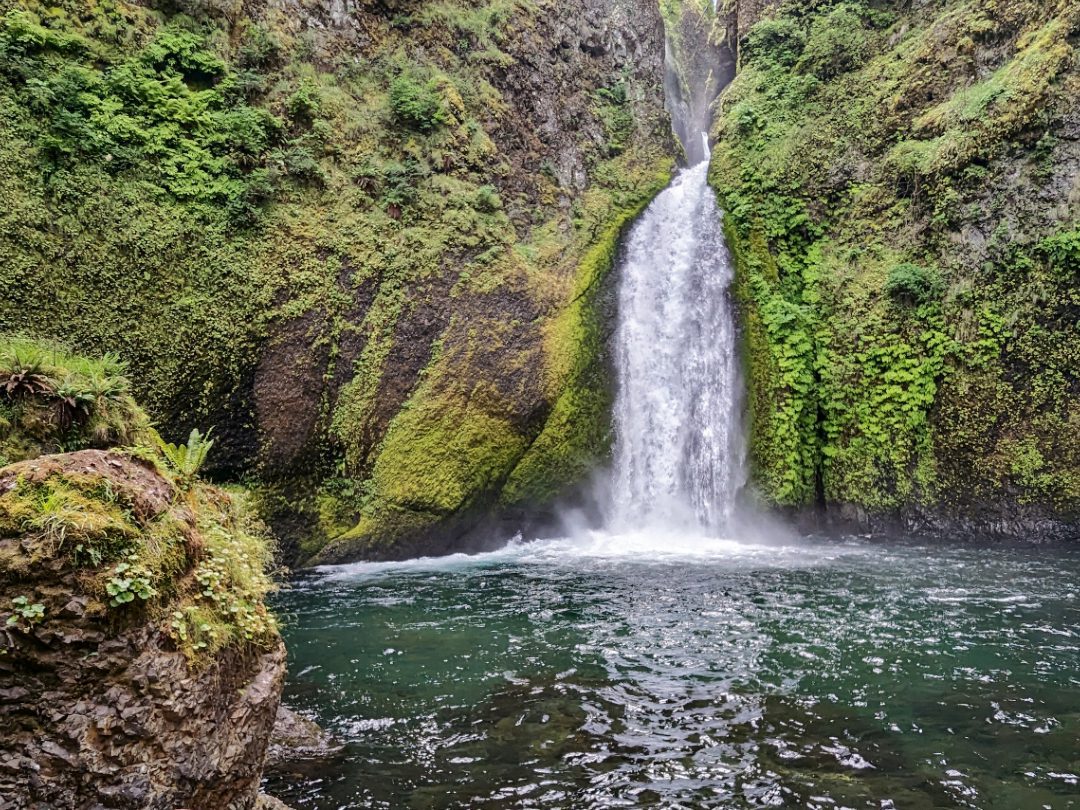
While the waterfall commanded attention, we couldn’t help but notice a persistent, high-pitched warble of a single bird bound and determined to be heard above the crashing water. It seemed impossible to find as the music shifted from place to place. But finally, we pinpointed the sound, finding a lone water ouzel announcing its territory to anyone who would listen. This strange, dull-colored bird is America’s only aquatic songbird, best known as the American Dipper.
We decided to stay awhile. We hadn’t packed a lunch but this would have been the perfect place to picnic by the water. Instead, we snacked on handfuls of gorp, watching the colors change with the moving light. From different angles, it was easier to see that this waterfall is several in one, with steep drops happening beyond the final descent immediately before us.
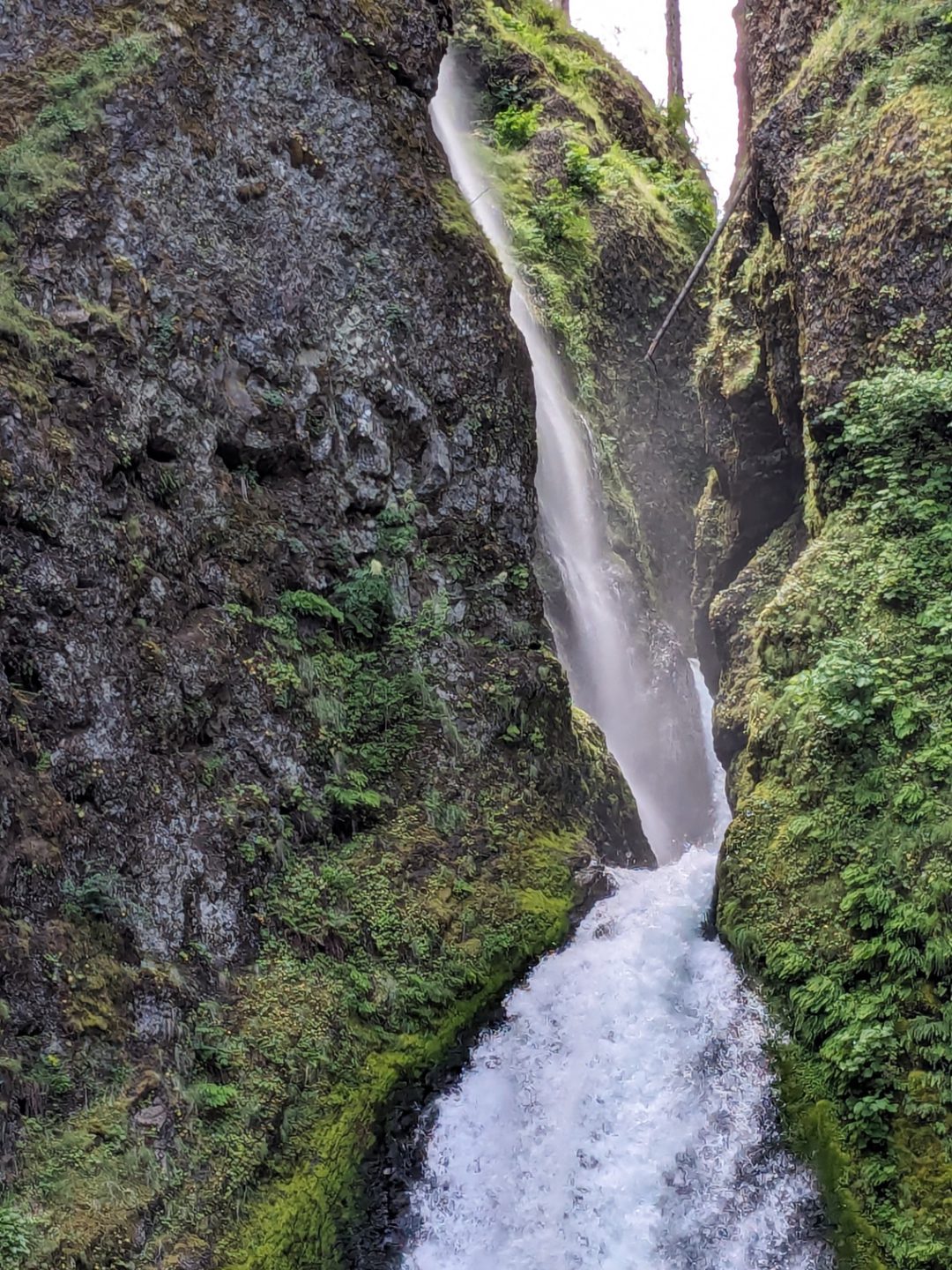
When we finally decided it was time to leave, we took the trail below us, knowing it would lead back to the fork. We had been able to see the lower trail from our high vantage point and could see some things we wanted to explore, like an opening in the rock wall that looked very much like a cave. It turned out to be a tube-like tunnel, reminding us of the Labyrinth of a Thousand Illusions. We were not inclined to crawl inside to see if it came out on the other side.

By hiking the low trail, we also knew that we would have to stop, turn around, and admire the view behind us. Those choosing the trail’s right fork would approach the waterfall in full view, passing inviting swimming holes along the way. This was another reminder that this is a place to visit again and again. How lucky we are to live close by!

Where is Wahclella Falls?
Wahclella Falls is about an hour from our home in North Portland, with light traffic. The trailhead is easily accessible from I-84 at the Bonneville Dam exit or the Historic Columbia River Highway.
Wahclella Falls Trailhead
Information For Your Trip
We highly recommend hiking this popular trail mid-week, especially in the spring and summer, when tourists visit the Columbia River Gorge in large numbers. We hiked on a Tuesday and passed very few people on the trail in the morning. When we finished our hike at mid-day, the parking lot was full.
Bring water, wear hiking boots or trail shoes, and be prepared for variable weather, no matter the season.
- Direction by Car, use WAZE and look for Wahclella Falls Trail.
- Direction by Public Transportation The closest bus appears to be Cascade Locks with the Columbia Gorge Express.

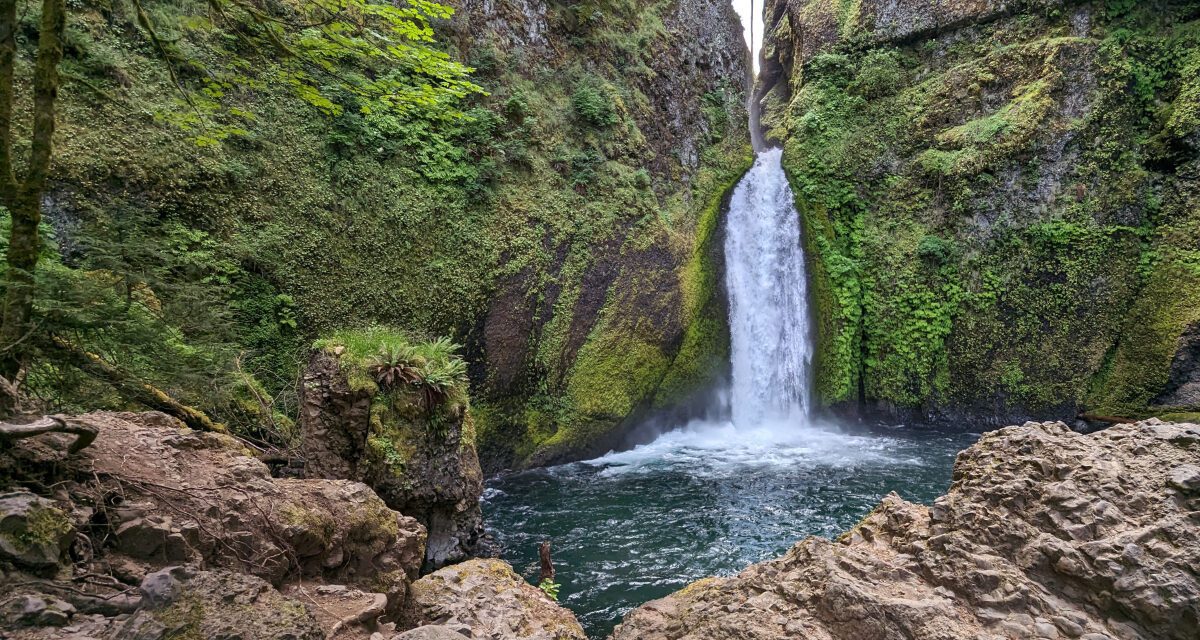




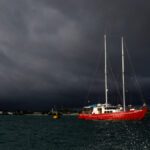






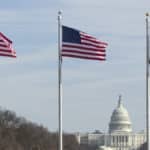









This is a wonderful article to come upon, I love seeking out waterfalls, but I to have to be weary of what the hike will do to me afterwards with my own medical limitations. But I will not give up on my adventures, I would love to find a group of like minded people’s seeking out the beauty that surrounds us. Please keep posting so that I can go and enjoy them also.
Good for you for not giving up on your adventures! It is so important to find ways to spend outdoors, no matter our physical limitations. I hope you find your community of like-minded adventure seekers. My guess is that they are out on the trail! I will be sure to post more about great places to get outdoors around Portland. Thanks so much for posting a comment!
Wow ! What a lovely description of a truly magical place !!! Thank you so much for sharing this !! I was also extremely happy to read your acknowledgment of the indigenous peoples and land that we are blessed to share !
I’m so happy you enjoyed this article. Thanks for letting me know. Comments like yours keep me writing!
This is where my wife and I were married. We hope to come back some day for a visit as it’s amazing!
Wow! What an excellent place to start your married life together. I hope you both get to visit again very soon. Thanks so much for sharing your experience at Wahclella Falls with us!
WOW …ITS A VERY NICE DESCRIPTION OF FALL…U HAVE NARATED ITS BEATY IS JUST LIKE ONE COULD ABLE TO SEE THE WATER FALL WITH UR NARRATION…THQ…
This is such a nice compliment! I really appreciate your kind words. Thanks for leaving a comment!
What an enticing article about a place near me that I’ve never heard of! Thank you for adding Wahclella Falls to my must-see list!
I appreciate your indigenous people acknowledgment and I look forward to your next article!
Thanks for the positive feedback, Brian! One of the joys of writing about the places I love is sharing them with others. Please do keep coming back to read more!